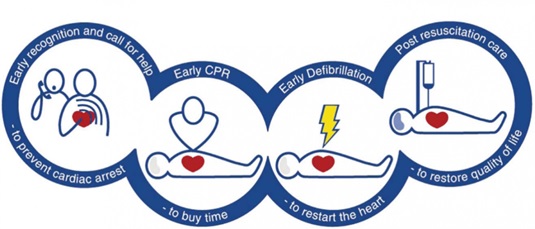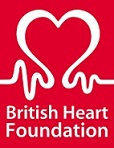About Cardiac Arrest
Cardiac Arrest is the term used to describe sudden cessation of heart function. A cardiac arrest happens when the heart stops beating. This is different to a heart attack, where a blockage in a blood vessel reduces the blood flow to the heart. A cardiac arrest may be caused by a number of heart attacks, but it can also be caused by things such as a serious injury, infection, or blood clot in the lungs.
After cardiac arrest occurs, blood stops being circulated to the vital organs and consciousness is lost within seconds. Unless cardiopulmonary resuscitation is started promptly death will occur within a few minutes.
Each year over 30,000 people in the UK receive resuscitation for an Out-of-Hospital Cardiac Arrest (OHCA). In the country as a whole the incidence of OHCAs that receive treatment is approximately 1 per 2000 inhabitants per year, but ranges more than 5-fold across the country.
The average age for cardiac arrest is about 69-years but it can happen in persons in the 3rd and 4th decade of life and even rarely among teenagers and young adults. Most events happen in men, the ratio of men to women for CA is 2:1.
Approximately half the time, the cardiac arrest event occurs in someone with a history of heart disease. However, frequently the cardiac arrest event is the first sign of an underlying problem, with heart disease. Collapse can occur with any premonitory symptoms whatsoever. Approximately 4 in 5 events happen in homes; about 1 in 5 occur in public locations.
Information collected by the Department of Health indicates that only 1 in every 20 people that have an OHCA survive to go home from hospital, and that there are large differences in the number of people that survive an OHCA depending on where they live. In simple terms people living in some parts of the country are twice or three times more likely to survive than in other areas.
The immediate treatment for a cardiac arrest is CPR (cardiopulmonary resuscitation); this is a combination of rescue breathing and chest compressions. Prompt and effective CPR is essential to prevent damage to vital organs, and increases the chance of survival. In addition to CPR other advanced treatments are given such as defibrillation (electrical shocks) and medications.
To reinforce the importance of time and key treatments proven to improve the number of people surviving, the concept of the “chain of survival” was introduced in the late 1980s. The first link in the chain is the need for a bystander or witness to the event to quickly call 999 and activate the EMS system. The second link is rapid provision of CPR, ideally through a bystander. The third link is early defibrillation. The fourth and final link is dependent on expert medical help so the sooner the bystanders call 999 the sooner the OHCA victim reaches hospital. Additional definitive care, is provided once the patient reaches the hospital emergency department and subsequently intensive care unit.

There have been many efforts to strengthen provision of emergency cardiac care, but little effort has been made to strengthen the information systems needed to measure various components of a community’s approach to CA.
The justification for enhanced data collection is straightforward. None of the factors that influence CA survival can be understood or improved without a basic data collection system that:
- Identifies CA events;
- Links data reported by various components of the EMS system; and
- Identifies patient outcomes.
In the absence of basic data on each link of the “chain”, EMS administrators and medical directors cannot determine where or how to focus their quality improvement efforts.

Project Overview
Information for Health Professionals
Information for the public
News and events
Publications
Interactive Map
Search the OHCAO website:
Enquiries:
Tel: 02476 572725
Email: ohcao@warwick.ac.uk
Address:
Warwick Clinical Trials Unit
Warwick Medical School
University of Warwick
Gibbet Hill Road
Coventry
CV4 7AL


